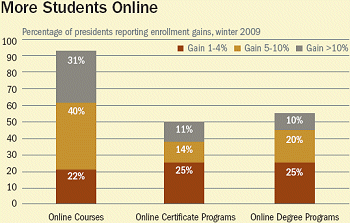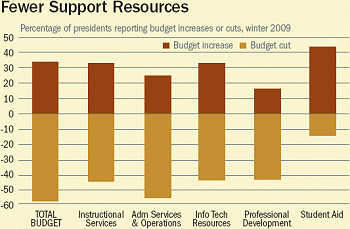Riding the Economy-- Both Up & Down
Community colleges are, like their institutional brethren, suffering from budget cuts due to the economic downturn. Yet, according a recent survey from the Campus Computing Project, they are also experiencing an enrollment boom that may be a result of the same economy. The survey, a joint effort with League for Innovation in the Community College and Pearson Education, canvassed 120 community college presidents during late February and early March 2009. Their responses to a range of state-of-the-campus questions offer insight into the dilemma community colleges find themselves in: doing more with less. For the full report, go here.
Overall Enrollment Leaps...
 Ninety-two percent of presidents reported an increase in overall enrollment over last year, across all student categories. Casey Green, director of the Campus Computing Project, suggests that students are flocking to community colleges because they are “buying down, coming back, looking for retraining.” Percentages of presidents reporting increased enrollments, in each student category:
Ninety-two percent of presidents reported an increase in overall enrollment over last year, across all student categories. Casey Green, director of the Campus Computing Project, suggests that students are flocking to community colleges because they are “buying down, coming back, looking for retraining.” Percentages of presidents reporting increased enrollments, in each student category:
- full-time 86%
- part-time 82%
- transfer 74%
- certificate programs 72%
- reverse transfer from 4-year colleges 62%
- workforce development 77%
And Online Enrollments Bound…
Almost all presidents (93%) reported increases in online course enrollment over last year, with 71% experiencing climbs of over 5% or more. A significant, though not as dramatic, percentage of presidents also reported growth in online certificate (50%) and online degree programs (55%). In a related finding, a great number of presidents said they have expanded or plan to expand over the next year online courses (82%) and online degree programs (75%) as a means of raising new revenues. But most presidents (89%) also indicated that student demand is the real driver behind increasing online offerings.
While Support Declines...
Higher enrollment figures stand in contrast to the budget cuts colleges are enduring. A majority of presidents (57%) said they have had overall cuts in their budgets from last year. They reported decreases in instructional services (44%), IT resources (43%), and admin services (56%). In related findings, while over half the presidents (54%) said they are hiring part-time faculty to keep up with enrollment demands, the same percentage acknowledged that they have no plans to hire more academic (53%) or vocational (54%) advisers. Around a third of presidents also report cuts in clerical support (39%) and facilities support (32%). Green is concerned that “the absence of the infrastructure creates an incomplete opportunity for students and, by extension, faculty who are dependent on a range of infrastructure services including academic and occupational counselors and IT user support services.” With online education in particular, Green says, “Infrastructure issues are critical,” especially for the adult learner who needs “the off-hour support.”
Source: The Campus Computing Project, 2009